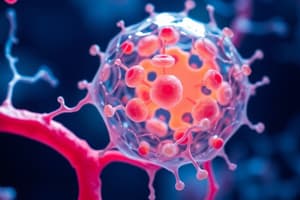Podcast
Questions and Answers
What is the difference between animal and plant cells?
What is the difference between animal and plant cells?
Plant cells have a cell wall and chloroplasts, while animal cells do not.
What is the difference between eukaryotic and prokaryotic cells?
What is the difference between eukaryotic and prokaryotic cells?
Eukaryotic cells have a nucleus and membrane-bound organelles, whereas prokaryotic cells do not.
How do you calculate magnification?
How do you calculate magnification?
Magnification is calculated by multiplying the objective lens magnification by the eyepiece magnification.
What is surface area to volume ratio in cells?
What is surface area to volume ratio in cells?
What role do enzymes play in biological processes?
What role do enzymes play in biological processes?
What does the fluid mosaic model describe?
What does the fluid mosaic model describe?
What is a semi-permeable membrane?
What is a semi-permeable membrane?
Which of the following terms describes a solution with a higher concentration of solute compared to another?
Which of the following terms describes a solution with a higher concentration of solute compared to another?
What are the light-dependent reactions of photosynthesis also known as?
What are the light-dependent reactions of photosynthesis also known as?
What is the main role of heterotrophs?
What is the main role of heterotrophs?
What is the purpose of the line of best fit in a graph?
What is the purpose of the line of best fit in a graph?
What is convergent evolution?
What is convergent evolution?
What is the theory of evolution?
What is the theory of evolution?
What do you understand by the term 'speciation'?
What do you understand by the term 'speciation'?
Which of the following represents a type of evolution involving large changes over time?
Which of the following represents a type of evolution involving large changes over time?
What are abiotic factors?
What are abiotic factors?
What term describes the different roles and positions species have in their environment?
What term describes the different roles and positions species have in their environment?
Flashcards are hidden until you start studying
Study Notes
Module 1
- Distinction between animal and plant cells includes presence of cell wall, chloroplasts in plants, and larger vacuoles in plant cells.
- Eukaryotic cells contain a nucleus and organelles, while prokaryotic cells lack a defined nucleus and are generally smaller.
- Magnification is calculated by multiplying the eyepiece lens magnification by the objective lens magnification.
- Surface area-to-volume ratio is critical in cell biology for nutrient absorption and waste production; smaller cells have a higher ratio.
- Enzymes are biological catalysts that speed up reactions; factors affecting them include temperature, pH, and substrate concentration.
- The fluid mosaic model describes the cell membrane structure, consisting of a phospholipid bilayer with embedded proteins.
- Semi-permeable membranes allow selective passage of substances; diffusion is movement from high to low concentration, while osmosis refers specifically to water movement.
- Hypertonic solutions have higher solute concentration, isotonic solutions are balanced, and hypotonic solutions have lower solute concentration.
- Graph analysis of temperature, substrate concentration, and pH is key in understanding enzyme activity and optimum conditions.
Module 2
- Photosynthesis consists of light-dependent reactions (occurring in thylakoids) and light-independent reactions (Calvin cycle in stroma), crucial for converting solar energy into chemical energy.
- Heterotrophs consume organic matter, while autotrophs produce their own food via photosynthesis or chemosynthesis.
- Identification of plant leaves and animal organs includes understanding their structure and functional roles within ecosystems.
- Line of best fit in graphing is essential for data analysis, indicating trends and correlations.
- Plant systems (e.g., vascular, root systems) and animal systems (e.g., circulatory, respiratory) have distinct characteristics suited for their respective functions.
- Specialization of cells in the human body, such as muscle, nerve, and epithelial cells, allows for diverse functions and efficiency.
Module 3
- Convergent evolution occurs when unrelated species develop similar traits due to similar environments or selection pressures.
- Divergent evolution happens when two related species develop different traits due to different environments or isolation.
- The theory of evolution explains the gradual changes in species over time through natural selection, genetic drift, and mutation.
- Evidence of evolution includes fossil records, homologous structures, and genetic similarities among species.
- Microevolution refers to small-scale changes within a species, while macroevolution involves larger-scale changes leading to the emergence of new species.
- Gradualism suggests that evolution occurs slowly over long periods, while punctuated equilibrium proposes that species remain stable for long periods followed by rapid changes.
- Understanding food webs and chains involves identifying producers, consumers, and decomposers, and their interactions within ecosystems.
- Studying species like the prickly pear and cane toad illustrates the effects of invasive species on native ecosystems.
- Quadrat and transect methods are sampling techniques for estimating population density and distribution in ecology.
- Capture-recapture methods are utilized for estimating animal populations, allowing ecologists to understand species dynamics.
- Speciation is the process by which new species arise, often through mechanisms like geographic isolation and reproductive barriers.
- Comparative embryology examines similarities in embryonic development, while comparative anatomy and genomics analyze structural and genetic relationships among organisms.
Module 4
- Food webs and chains illustrate energy flow through ecosystems, showing the interdependencies of species.
- Understanding layers in predation chains helps comprehend the roles of producers, primary consumers, and secondary consumers in energy transfer.
- Ecological niches encapsulate the role of a species in its environment, involving habitat, resource use, and interactions.
- Resource partitioning is the process where species divide resources to minimize competition, enhancing biodiversity.
- Selection pressures (biotic and abiotic) drive natural selection, determining which traits increase survival and reproduction.
- Natural selection is the mechanism through which advantageous traits become more common in a population over generations.
- Abiotic factors (like climate and soil) and biotic factors (like competition and predation) influence ecosystem dynamics.
- Organisms display structural, physiological, and behavioral adaptations to survive in their environments.
- Interspecific competition occurs between different species, while intraspecific competition occurs within the same species.
- Types of sampling techniques include random, systematic, and stratified sampling, each serving different research purposes in ecological studies.
Studying That Suits You
Use AI to generate personalized quizzes and flashcards to suit your learning preferences.




